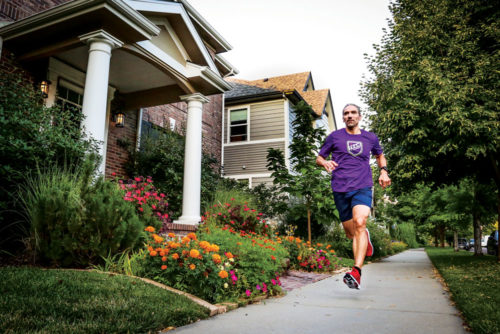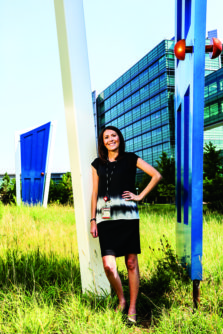
“Opening Doors” sculptures by Christopher Weed are a fitting backdrop for University of Colorado researchers Dr. James DeGregori (left) and Dr. Daniel Pollyea (right) who are working on treatment for leukemia. Stapleton dentist Dr. Brett Kessler (second from right) has been fundraising for leukemia for almost two decades. Paige McCoy is a leukemia survivor who was treated at Presbyterian/St. Luke’s Medical Center..
University of Colorado researchers have had “unbelievable” results in a clinical trial for a type of leukemia, with 80% to 90% of patients going into complete remission. Surprisingly, much of the funding for such research comes not from the government but through grants from private fundraising. Read about these researchers and a local effort that is underway to add $100,000 to their funding.
Fundraisers and Researchers: A Winning Team for Survivors
“I was so fortunate to beat leukemia,” says Paige McCoy, 31. “The right tools and research allowed me to survive.”
Much of the funding for research on leukemia that saves the lives of patients like Paige comes from the fundraising efforts of people like Stapleton dentist Brett Kessler. For almost two decades, Kessler has devoted his athletic endeavors to the cause. His efforts hit close to home when a Leukemia & Lymphoma Society (LLS) team he was on in the early 2000s raised $2 million that was sent to a Seattle researcher who was working on a revolutionary treatment for a specific leukemia. It was a grim but fitting coincidence when his mother, Gloria Kessler, was diagnosed in 2009 with that type of leukemia. “Mom would not have lived the almost nine years that followed her diagnosis without that research. So I know the value of research dollars.”
Kessler’s upcoming challenge is the Ironman World Championship in Kona, Hawaii on October 13,2018. His goal is to raise $100,000 for The Leukemia & Lymphoma Society—which will help fund the work of CU researchers Dr. James DeGregori and Dr. Daniel Pollyea, featured on the next page.
Making a Difference in the Fight Against Cancer
Recovery stories like those of Paige McCoy and Gloria Kessler depend on people like Brett Kessler who commit to raising money for research on new life-saving treatments.
“It’s an opportunity to make a difference in the fight, while doing something I love,” says Kessler, who has lived in Stapleton since 2002 with his orthodontist wife, Gina, and their four children, ages 8 to 18.

Stapleton dentist Brett Kessler trains for the upcoming Ironman World Championship in Hawaii.
His goal is to raise $100,000 for the Leukemia and Lymphoma Society in honor of his mother.
Since 1994 he has competed in dozens of triathlons and marathons, five half-Ironman competitions and four ultra-marathons—including a 50-mile race. He started competing for The Leukemia & Lymphoma Society (LLS) in 2001 and then coached the Team in Training program for seven years. The Team in Training program prepares athletes for competitive endurance challenges to raise money for cancer research. “We have raised a bunch of money to cure blood cancers,” he says.
The LLS website says the organization has invested more than $1.2 billion in groundbreaking research since 1949.
Kessler’s mom died in 2017 at age 73. Now he competes in honor of her. Kessler says the Ironman Competition will be “an adventure that will push my limits emotionally, physically and spiritually every day. Mom goes with me—I think of her a lot.”
Ironman competitors tackle a 2.4-mile ocean swim, a 112-mile bicycle ride and a 26.2-mile run—in that order—without a break. “Most of the competitors have won another Ironman, so this is no casual race,” Kessler says. “I’ll be with the world’s fastest. It’s like the Olympics for me.”
Kessler wants people to understand that their contributions to medical research have life-changing impacts. “In the late ‘90s during my hospital oncology residency, many people died of leukemia or lymphoma because there wasn’t much treatment at the time. New treatments are raising survival rates dramatically.”
McCoy says it’s important to help the scientists so they can help patients. “There’s no cure for leukemia, so research will help us find it. We have drugs to get it into remission, but we need more protocols. Researchers are also working on ways to reduce the side effects of cancer treatment. People die from the treatments because they are so hard on the body.”
In October 2015, McCoy was diagnosed with acute lymphoblastic leukemia, a type of leukemia that starts in the bone marrow. Between October and January, she underwent chemotherapy, radiation and finally a bone marrow transplant at Colorado Blood Cancer Institute in partnership with the Sarah Cannon Cancer Institute at Presbyterian/St. Luke’s Medical Center. The transplant put the cancer in remission in January 2016.
McCoy says that since she’s remained in remission past the 2-1/2-year mark, her chances of relapse are very low. “I’ve gone back to living.”

After surviving leukemia, Paige McCoy changed jobs and now works with cancer patients.
Beating leukemia changed McCoy’s life. Before she got sick, she was a paralegal for a law firm—but after her recovery she changed careers. She now works in administration in the oncology department at CU Anschutz Medical Campus with the Cancer Clinical Trials Office. “I wanted to work in the medical field on behalf of patients.”
As the LLS’s 2018 Honored Hero for the annual Light the Night fundraiser, McCoy speaks at events to provide inspiration and support for the fundraising programs of the nonprofit. “I am a different person after leukemia. I have a new perspective. I learned the importance of supporting patients and caregivers. I was lucky because I was young going through cancer, and now I get the rest of my life to give back.”
To donate to Brett Kessler’s fundraising effort, see: https://pages.teamintraining.org/rm/ironworl18/bkessler
For more information about The Leukemia & Lymphoma Society visit www.lls.org.
Private Grants Are Vital to Cutting-Edge Research
The connection between running a race and curing cancer might seem abstract, but it’s not to local researchers who benefit from The Leukemia & Lymphoma Society (LLS) funding.
In fact, it wouldn’t be a stretch to say that LLS grants have led to what may be one of the most significant advances for one of the most common and vicious types of blood cancers, acute myeloid leukemia (AML).
Although leukemia, lymphomas and myelomas are rare compared to solid cancer tumors, nearly 175,000 new cases are diagnosed every year, with an estimated 1.3 million people affected by these blood cancers. AML, which is most prevalent in older adults, has the lowest survival rate of any leukemia, at just 27.4% over five years among adults.
But this grim statistic could soon change due to the research of Dr. Dan Pollyea and his team of clinical researchers at the University of Colorado School of Medicine.

Dr. Daniel Pollyea’s research results have been “unbelievable,”getting 80% to 90% of people into remission.
“For many decades, the only…available therapies [for AML] involved really intensive chemotherapy,” says Pollyea, “And it can work for some people, but it’s very toxic.” Older adults struggle to withstand the side effects, and outcomes have been poor, he said.
The last decade of research by investigators at the University of Colorado has been focused on the leukemia stem cell population, the cells that give rise to leukemia and cause relapses. Pollyea and his team have sought weaknesses in this leukemia stem cell population, specifically focusing on a protein called BCL2.
They embarked on a clinical trial program three years ago, focused on an inhibitor of the BCL2 protein. “Our unique interest in this was that this could potentially be the first therapy that could effectively eradicate leukemia stem cell populations,” said Pollyea. “If you can really eradicate the leukemia stem cells, then you can potentially cure this disease.”
And the results of their clinical trials are “unbelievable” said Pollyea. “We can really get 80% to 90% of people into complete remission with this approach.” The mostly outpatient, well-tolerated, non-intensive chemotherapy has led to durable responses, with few relapses and extended survival rates. “In some cases we can now prove that…this is a potentially curative regimen,” added Pollyea.
This game-changing research can be traced back to funding that has come through grants like those provided by the LLS.
“LLS has been crucial personally to my career,” says Pollyea. “I was funded by Leukemia & Lymphoma Society as a fellow to work on projects that led to my position here at the University of Colorado.” In addition, the key basic research from the lab of Dr. Craig Jordan, also at the University of Colorado School of Medicine, that demonstrated the strong dependency of leukemia stem cells on the BCL2 protein was also funded by the LLS. And in a climate of potentially shrinking government funding for research, private grants like those made by LLS are vital to cutting-edge research.
Dr. James DeGregori at the University of Colorado School of Medicine says that he has received at least half his funding for leukemia research from LLS grants over the years and continues to seek private funding.
DeGregori brings an evolutionary biology approach to cancer research. “From my lab’s perspective, we don’t get cancer because, during youth, our tissues are maintained relatively consistently,” explains DeGregori. “If you were to look at the lungs of a 20-year-old nonsmoker and a 40-year-old nonsmoker, they really wouldn’t look that different. But later in life, they start to look different. Things start to change.”
And it is with the changes in the aging human body that opportunistic cancer cells find a way to take hold, developing into solid tumors or blood cancers, like leukemia and lymphoma, he theorizes.

Dr. James DeGregori is researching ways to mitigate changes that occur with aging, which create an opportunity for cancer cells to take hold.
“How can we mitigate those changes, and which changes need to be mitigated?” asks DeGregori. “I’d love to make a tissue completely youthful-like. If I could do that, then you’d essentially not only avoid cancer but you’d avoid aging.”
While this fountain of youth is thus far still elusive, the research of DeGregori and his colleagues is pointing the way towards clinical interventions in the aging process that could interfere with cancerous proliferation.
“We’ve designed strategies that reduce cancer incidence in old mice. We don’t completely rejuvenate the tissue, but there’s a fraction of the age-associated changes that we do reverse,” explains DeGregori.
The approach used in humans will likely be different than that used in mice, he added, but “By learning what changes are key, we can design more targeted interventions that would allow us to basically change the landscape just enough to disfavor cancer without being so disruptive so as to prevent healthy immune responses.”




0 Comments